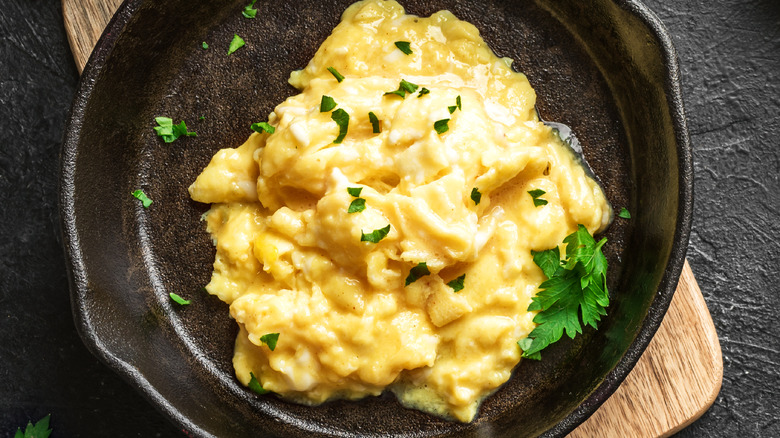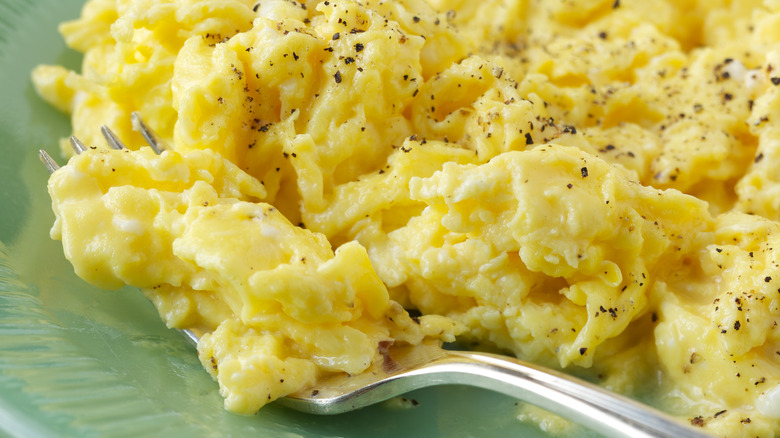This Is The Difference Between Silken Eggs And Scrambled Eggs
If you're a fan of eating eggs for breakfast, you've probably mastered a few basic techniques by now. Most egg lovers can whip them up scrambled or over-easy, but if you're a true aficionado, you may also know how to make them poached, over-medium, soft-boiled, and hard-boiled. But beyond the methods you'd see at a diner in the U.S., there are plenty more to learn, especially when looking at recipes from other countries.
When dipping your toe in techniques from around the world, Chinese silken eggs are a beautiful place to start. We love our scrambled eggs soft and creamy, but this Chinese dish takes a smooth texture to a whole new level. In fact, when you first see silken eggs, you may mistake them for a dessert — but while it's true these bowls look like custards, they're generally consumed as a savory breakfast instead. And once you learn how to make them, you'll find that they actually have very little in common with scrambled eggs. You'll need different tools and ingredients (besides the main one, of course) to whip up Chinese silken eggs, but the results are so velvety smooth, this dish is worth learning how to make.
What are scrambled eggs?
Scrambling your eggs is one of the most fool-proof ways to cook them. All you need is a pan, a spatula, and a stovetop set to low heat. This mostly hands-off method requires hardly any technique — all you really need to do is beat the raw eggs in a bowl, then push them around in the pan until they're cooked. But to make this dish extra soft and fluffy, swirl them in a circular motion and take them off the stove just before they're fully done. And of course, you can include a wide array of mix-ins, such as tofu, ricotta, and capers.
The basic method for making scrambled eggs goes all the way back to ancient Rome, although a specific mention of the dish can be found in a 14th century Italian cookbook. The now-classic morning meal of bacon and eggs didn't pop up until the 1920s, when physicians at the time touted the benefits of a heavy breakfast. In the modern day, however, scrambled eggs looks different around the world. The English version tends to incorporate a little milk, while French scrambled eggs have a runnier texture and a richer flavor (typically due to added butter). Portugal's variety, bacalhau à brás, on the other hand, is a hefty meal that includes shredded cod, onions, potatoes, and black olives.
What are silken eggs?
Compared to the wide variety of scrambled egg dishes you'll see around the world, Chinese silken eggs are much more specific. They can also be called water eggs or Chinese steamed eggs, which gives you some insight into how they're made. Just like with the scrambled dish, you'll start off by beating eggs in a bowl, although you'll want to add a little water and salt. Then strain the mixture, cover the resulting bowl with cling wrap, and steam it — ideally on top of a steamer rack placed over a little boiling water, although you can also use a steam basket. You want the eggs to be custard-like in texture when you pull them off the heat, with a solid but jiggly consistency.
Chinese silken eggs likely started as a Cantonese dish, and early versions incorporated just the main ingredient, salt, and scallions. But in today's world, you'll see it with a variety of toppings. Soy sauce, sesame oil, and chili oil are popular, and you can even make shallow slices into the surface of the dish so that these liquids seep further in. Fancier versions incorporate minced pork, prawns, chives, and veggies like sliced carrots. It takes a little technique and experimentation to make this dish if you've never done it before, but you'll be rewarded with a smooth, savory custard for breakfast.


